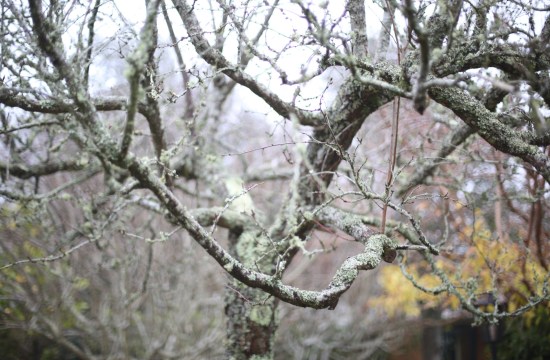
I made this last weekend for a relaxed lunch with family and friends. It was served with fermented Indian dosas, spicy chickpea sambar, carrot palya and a bowl of sliced avocados with arugula leaves and mustard micro-greens. After a last minute panic, thinking this may not be enough, I had moong dal sprouts waiting to be used. Initially, I had soaked them for fermented moong bean pancakes but had not got around to grinding them, so they ended up as sprouts waiting for a purpose.



-sweet winter plum tree. In Summer, it is laden with fruit that is brilliant in colour.
-went outside to find her – soft and silent when she is out of the water.
-slate skies, frosty mornings and fingers tingling.

sprouted moong dal coconut lemon palya
Serves 4
Any left-overs from the fresh coconut can be kept in the freezer, otherwise, it tends to go off before it can be used. If you are unable to obtain fresh coconut, replace with ¾ cup unsweetened, dried, shredded coconut. The urad and chana dal add a nice crunch, however, if you are unfamiliar with these, they can be omitted and replaced with roughly chopped cashews or almonds, frying them until golden. The secret to getting this simple palya just right is to saute the sprouts very minimally so that they are just slightly soft, but still, retain their freshness and are not overcooked.
During colder seasons, sprouts act as an excellent source of fresh vegetables. Cooking them at this time of year balances their cooling nature. When lightly steaming or sautéing, they still keep their vital and energizing qualities.
ingredients
2½ cups sprouted whole moong dal (whole mung beans)
1½ cups freshly grated coconut
1 Tbsp oil/ghee
1 heaped tsp urad dal
1 heaped tsp channa dal
½ tsp cumin seeds
10 curry leaves
zest from a lemon
juice from a lemon
1 cup chopped coriander
salt and pepper, to taste
pre-preparation
1. For sprouting, follow the directions here, using 1 cup whole moong dal. After an overnight soak, the sprouts are ready in just two-three days.
preparation
2. Grate the fresh coconut into fine shreds until you have 1½ cups. Set aside.
3. In a skillet over medium heat, add the ghee/oil and urad and channa dal, fry until both dals are golden-brown, then add cumin seeds and curry leaves – fry for 30 seconds. Add in the sprouts and saute for a few minutes, stirring to keep the sprouts moving.
4. Add the grated coconut and saute for 2 more minutes, or until the sprouts are slightly wilted, but still hold their shape.
5. Transfer to a medium-sized serving bowl and mix in the lemon zest, lemon juice, coriander and season with salt and freshly ground pepper.
6. Taste and adjust the seasoning, adding more lemon or salt as needed. Serve warm or at room temperature.

Goodness shared by Stacey







